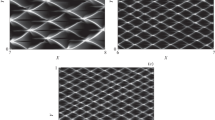Abstract
In this paper, the effect of argon and ozone addition to a stoichiometric hydrogen–air mixture on the parameters of the detonation wave is studied numerically in order to reduce the wave propagation velocity and the temperature of combustion products without significantly increasing the detonation cell, which is a fundamental characteristic of the detonation capacity of the mixture. It is found that the molar fractions of the introduced additives can be selected so that the cell size of the detonation wave in the resulting mixture will be close to the average cell size in the pure mixture while the wave velocity and temperature of the detonation products will be significantly reduced. A detonation wave in a mixture with additives at concentrations that do not allow a significant increase in the cell size is found to be more resistant to disturbances caused by obstacles located in the channel than that in a pure mixture. This study is performed using a second-order scheme based on Godunov’s method; a detailed kinetic mechanism is used to simulate chemical reactions.


Similar content being viewed by others
REFERENCES
V. A. Levin and T. A. Zhuravskaya, Tech. Phys. Lett. 46, 189 (2020). https://doi.org/10.1134/S1063785020020248
T. A. Zhuravskaya and V. A. Levin, Fluid Dyn. 55, 488 (2020). https://doi.org/10.1134/S0015462820040138
V. A. Levin and T. A. Zhuravskaya, Proc. Steklov Inst. Math. 300, 114 (2018). https://doi.org/10.1134/S0081543818010091
V. A. Levin and T. A. Zhuravskaya, Combust. Sci. Technol. (2019). https://doi.org/10.1080/00102202.2018.1557641
J. Crane, X. Shi, A. V. Singh, Y. Tao, and H. Wang, Combust. Flame 200, 44 (2019). https://doi.org/10.1016/j.combustflame.2018.11.008
D. S. Kumar, K. Ivin, and A. V. Singh, Proc. Combust. Inst. 38, 3825 (2021). https://doi.org/10.1016/j.proci.2020.08.061
Thermodynamical Properties of Individual Substances, Ed. by V. P. Glushko (Nauka, Moscow, 1978), Vol. 1, Part 2 [in Russian].
L. V. Bezgin, V. I. Kopchenov, A. S. Sharipov, N. S. Titova, and A. M. Starik, Combust. Sci. Technol. 185, 62 (2013). https://doi.org/10.1080/00102202.2012.709562
A. V. Rodionov, USSR Comput. Math. Math. Phys. 27, 175 (1987). https://doi.org/10.1016/0041-5553(87)90174-1
Vl. Voevodin, A. Antonov, D. Nikitenko, P. Shvets, S. Sobolev, I. Sidorov, K. Stefanov, Vad. Voevodin, and S. Zhumatiy, Supercomput. Front. Innov. 6 (2), 4 (2019). https://doi.org/10.14529/jsfi190201
F. Pintgen, C. A. Eckett, J. M. Austin, and J. E. Shepherd, Combust. Flame 133, 211 (2003). https://doi.org/10.1016/S0010-2180(02)00458-3
G. Yu. Bivol, S. V. Golovastov, and V. V. Golub, Shock Waves 28, 1011 (2018). https://doi.org/10.1007/s00193-018-0831-3
O. V. Sharypov and Ye. A. Pirogov, Combust. Explos. Shock Waves 31, 466 (1995). https://doi.org/10.1007/BF00789368
A. Teodorczyk and J. H. S. Lee, Shock Waves 4, 225 (1995). https://doi.org/10.1007/BF01414988
M. I. Radulescu and J. H. S. Lee, Combust. Flame 131, 29 (2002). https://doi.org/10.1016/S0010-2180(02)00390-5
T. A. Zhuravskaya, Fluid Dyn. 42, 987 (2007). https://doi.org/10.1134/S0015462807060142
H. Qin, J. H. S. Lee, Z. Wang, and F. Zhuang, Proc. Combust. Inst. 35, 1973 (2015). https://doi.org/10.1016/j.proci.2014.07.056
Funding
This work was supported by the Ministry of Science and Higher Education of the Russian Federation, agreement no. 075-15-2020-806, dated September 29, 2020.
Author information
Authors and Affiliations
Corresponding authors
Additional information
Translated by A. Ivanov
Rights and permissions
About this article
Cite this article
Levin, V.A., Zhuravskaya, T.A. Control of Detonation Combustion of a Hydrogen–Air Mixture by Argon and Ozone Addition. Dokl. Phys. 66, 320–324 (2021). https://doi.org/10.1134/S1028335821110057
Received:
Revised:
Accepted:
Published:
Issue Date:
DOI: https://doi.org/10.1134/S1028335821110057



